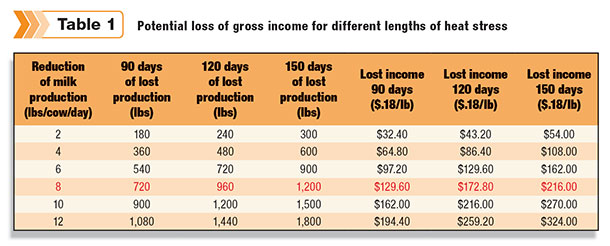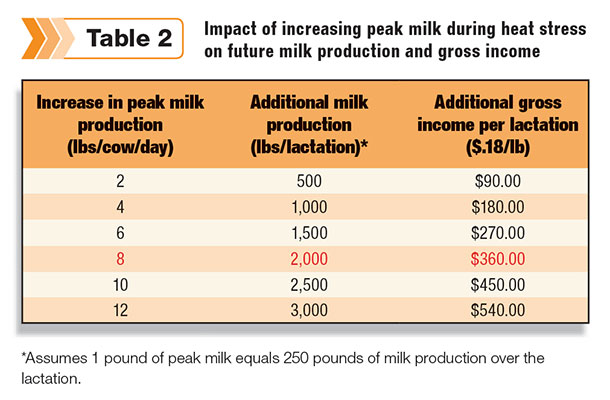Taking a few minutes to calculate heat stress losses and their impact on your dairy’s bottom line can help you strategize for better heat abatement, which could mean more milk, improved fertility and even healthier calves.
Last fall, we talked about “keeping your cool” over lost revenues due to heat stress. One of our suggestions was to go back and analyze your system to identify the root causes and effects of heat stress so you can develop an effective heat abatement program for 2014.
On the surface, you can perform an easy analysis using simple data ( Table 1 ):
Loss of milk production due to heat stress (pounds per cow per day) x Days of lost production (calculated per pound) x Lost income days (dollars per pound)
This is your simple milk production loss per cow due to heat stress.

Let’s look at a moderate example of 8 pounds of lost milk production. According to Table 1, an 8-pound milk reduction per cow per day over the course of 120 days of lost production at $0.18 per pound of income, milk value lost due to heat stress alone would be $172.80 per cow. Consider this effect across a herd of 200 milking cows. Your simple milk production revenue loss due to heat stress would be $34,560.
This is only the surface of the true impact of heat stress on your bottom line. If you assume that 1 pound of milk equals 250 pounds of milk production over the full lactation, the loss of 8 pounds in our example would equate to an additional 2,000 pounds of milk loss over the remaining lactation.
Multiply that by $0.18 per pound, and that equals an additional gross income loss of $360 per cow. The effect on a 200-cow herd is $72,000 plus the $34,560. Your heat stress loss has jumped to $106,560.
However, looking at Table 2 , we can see the potential for a more productive and profitable lactation as a result of minimizing heat stress. This comes in the form of higher peak milk production.

Clearly, the environment of a dairy cow directly affects milk production, and it also influences health, reproduction and genetic potential.
Dr. Sha Tao and Dr. Geoffrey Dahl at the University of Florida concur that heat stress abatement during late gestation increases milk production during the next lactation, as well as subsequent lactations. However, they also conclude that dry period cooling affects milk production, feed intake, bodyweight and reproduction, along with future performance of the calf.
Cooling dry cows improves the immune function of these animals during the critical transition period. It is suggested that with proper heat abatement, air velocity and soaking and cooling during the complete dry period, immune cells are more prolific, with greater killing ability when exposed to pathogens ex vivo in early lactation. The enhanced immunity combats metritis and mastitis, primarily for neutrophil function.
Further, research shows that late-gestation heat stress reduces the gestation period by as long as four days. Calves born from heat-stressed cows are 13 percent smaller than their herdmates with a tendency toward compromised immune function. Sha and Geoff’s study concluded in their test that proper dry cow cooling results in healthier calves.
The additional cost of heat stress hits the bottom line when it comes to fertility. As the cow’s core body temperature increases by as little as 0.9 degrees, cellular function is compromised, and the chance of an aborted embryo increases by 13 percent.
Clearly, blood flow to the skin is increased as body temperature elevates; therefore, the result is less blood flow to the organs of the reproductive system.
Oocyte health is critical for fertility but can also be disturbed by heat stress. When an oocyte is not formed properly in the early stages or is negatively affected by stress caused by elevated temperatures, the embryo will likely develop abnormally or die.
Noting that the ovarian follicle initiates the oocyte about three months earlier, any heat stress during this period can compromise follicular function. It is important to prevent any damage to the follicle and oocyte before fertilization occurs. It is critical to eliminate heat stress to prevent damage to the embryo, especially during the first few critical days of life.
Now, let’s flip the coin to the other side of the equation: the cost of heat abatement. The dairy producer’s goal is to improve margins while maximizing the return on investment (ROI). The simple approach is to evaluate the inputs, including a combination of fixed and variable costs.
Fixed costs include ventilation and sprinklers. Variable costs like energy, plus the cost of water, will equal your basic operating cost. Maintenance cost for lubricating and repairs should also be calculated into this figure.
When making purchases, consider manufacturers who provide remote kits for lubrication, ease of belt replacement and other value-added features that reduce labor time for maintenance and prolong the life of your investment.
These details factor into the total cost of the operation. It is also critical that the equipment you purchase has test data from credited testing labs.
Bioenvironmental and Structural System (BESS) Laboratory is one of the most notable of the independent testing laboratories and considered to be a solid standard for comparing data and results. This assures you will get the equipment you need to reduce heat stress within your operation.
For cross ventilation and tunnel ventilation, it is also important to compare a product’s air velocity, measured in cubic feet per minute (CFM) and CFM-per-watt at accurate static pressures. Most barns run 0.15 to 0.2 static pressure when in operation.
To be accurate in your evaluation of products, compare them at your operational standards. Quality manufacturers build products to hit the sweet spots for CFM-per-watt at operational levels, giving you the best ROI on your capital investment.
Comparing products at non-operational levels may result in lower performance and higher operational cost. It can all hit your bottom line.
Life expectancy of your capital investment in equipment for heat abatement should also be considered. Labor minutes and contracted labor to replace and repair equipment can add up quickly.
In addition, it can also take your team away from other critical tasks of herd management that can yield better results and better returns on the investment of their time.
Heat stress in your herd can have dramatic effects on your bottom line, so keep your cool as we head out of winter. Be prepared with a heat abatement plan when that first 68-degree day hits your dairy. It will only get warmer from here. PD
Feel free to contact Sha or Geoff to learn more on their study.
References omitted due to space but are available upon request. Click here to email an editor.

-
James Kleinke
- Vice President of Agriculture and Horticulture Sales and Marketing
- Schaefer Ventilation Equipment
- Email James Kleinke







